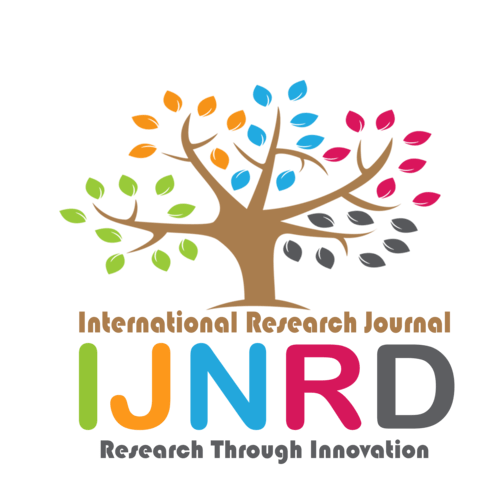|
|||||||||||||||

|
INTERNATIONAL JOURNAL OF NOVEL RESEARCH AND DEVELOPMENT International Peer Reviewed & Refereed Journals, Open Access Journal ISSN Approved Journal No: 2456-4184 | Impact factor: 8.76 | ESTD Year: 2016 Scholarly open access journals, Peer-reviewed, and Refereed Journals, Impact factor 8.76 (Calculate by google scholar and Semantic Scholar | AI-Powered Research Tool) , Multidisciplinary, Monthly, Indexing in all major database & Metadata, Citation Generator, Digital Object Identifier(DOI) |
||||||||||||||
Issue: May 2024
Volume 9 | Issue 5
Review Result and Publication of Paper within : 2-3 days
Click Here For more DetailsFor Authors
Forms / Download
Published Issue Details
Editorial Board
Other IMP Links
Facts & Figure
Impact Factor : 8.76
Issue per Year : 12
Volume Published : 9
Issue Published : 96
Article Submitted :
Article Published :
Total Authors :
Total Reviewer :
Total Countries :
Indexing Partner
Join RMS/Earn 300
Licence
This work is licensed under a Creative Commons Attribution-NonCommercial 4.0 International License







|
Published Paper Details
|
|
| Paper Title: | Review of abiotic stress tolerance of African rice (Oryza glaberrima) |
| Authors Name: | Dr. Shaibu Abraham Attah , Dr. Vimal Semwal Kumar , Dr. Francis Nwilene , Dr. Adeoti Adewale O. , Audu Sale Dogo |
| Download E-Certificate: | Download |
| Author Reg. ID: |
IJNRD_211698
|
| Published Paper Id: | IJNRD2401034 |
| Published In: | Volume 9 Issue 1, January-2024 |
| DOI: | |
| Abstract: | Abstract The utilization of Oryza glaberrima in a number of abiotic stresses such as drought iron toxicity, submergence, salt tolerance and weed competitiveness and ability to grow under low input soil condition has been reported in several literatures. Despite its utilization, hybridization between O. glaberrima and O. sativa hampered by high sterility phenomenon in interspecific F1 and in early progenies development. Though, African rice species (Oryza glaberrima) has been used in interspecific hybridization with Oryza sativa with combine yield traits and resistant to some abiotic stresses that are uniquely adapted to Africa growing environment. The high rate of sterility in the crosses between (O. sativa x O. glaberrima) have been confirmed to reduce the required maximum breakthrough in interspecific hybridization of these species. Thus, information on crossing barrier and hybrid sterility phenomenon expressed in O. sativa x O. glaberrima crosses, led to the recent development in breeding and molecular markers and linkage map approach of O. glaberrima which provides the opportunity to rationalize introgressions between the two cultivated rice species (O. glaberrima x O. sativa). Genetic models for the female sterility between the two cultivated species for their full utilization in rice improvement for abiotic stress tolerance have been proposed. The recent achievements in marker assisted selection using molecular tools for introgression of desirable traits and the development of such introgressed desirable traits of interests and elimination of sterility genes through interspecific hybridization and backcrossing represents a very high potential to create new genetic and transgressive variation that with be useful for developing rice tolerant to various abiotic stresses. In this effort, several approaches to abiotic stress tolerance have been developed starting from field screening and use of molecular tools. The interspecific and backcross breeding methodology is anticipated to make this approach feasible. It is expected that the results will produce complimentary breeding techniques that will provide (i) water information of field phenotyping and systematic assessment of the useful heritable resources exhibit by Oryza glaberrima, (ii) substantiate on empirical data on Oryza glaberrima for drought tolerance breeding and (iii) tools for genetic analysis of O. glaberrima germplasm. Though, the overall goal for the use of O. glaberrima in breeding rice for abiotic stress tolerance is challenging, but promising if we understand the genetic base of the two cultivated species, this can be widened for its exploitation in developing rice with higher yield and tolerant in abiotic stresses under harsh environmental conditions of Africa. |
| Keywords: | Key words: Abiotic, Breeding, Drought, Genome, Germplasm, Interspecific, Oryza, Species, Stress |
| Cite Article: | "Review of abiotic stress tolerance of African rice (Oryza glaberrima)", International Journal of Novel Research and Development (www.ijnrd.org), ISSN:2456-4184, Vol.9, Issue 1, page no.a298-a317, January-2024, Available :http://www.ijnrd.org/papers/IJNRD2401034.pdf |
| Downloads: | 000118762 |
| ISSN: |
2456-4184 | IMPACT FACTOR: 8.76 Calculated By Google Scholar| ESTD YEAR: 2016 An International Scholarly Open Access Journal, Peer-Reviewed, Refereed Journal Impact Factor 8.76 Calculate by Google Scholar and Semantic Scholar | AI-Powered Research Tool, Multidisciplinary, Monthly, Multilanguage Journal Indexing in All Major Database & Metadata, Citation Generator |
| Publication Details: |
Published Paper ID:IJNRD2401034 Registration ID: 211698 Published In: Volume 9 Issue 1, January-2024 DOI (Digital Object Identifier): Page No: a298-a317 Country: Ibadan, , Oyo, Nigeria Research Area: Science Publisher : IJ Publication Published Paper URL : https://www.ijnrd.org/viewpaperforall?paper=IJNRD2401034 Published Paper PDF: https://www.ijnrd.org/papers/IJNRD2401034 |
| Share Article: | |
|
Click Here to Download This Article |
|
| Article Preview | |
|
|
|
Major Indexing from www.ijnrd.org
| Semantic Scholar | Microsaoft Academic | ORCID | Zenodo |
| Google Scholar | ResearcherID Thomson Reuters | Mendeley : reference manager | Academia.edu |
| arXiv.org : cornell university library | Research Gate | CiteSeerX | PUBLON |
| DRJI | SSRN | Scribd | DocStoc |
ISSN Details
 |
 |
ISSN: 2456-4184
Impact Factor: 8.76 and ISSN APPROVED
Journal Starting Year (ESTD) : 2016
DOI (A digital object identifier)
Conference
Open Access License Policy
Important Details
Social Media
| Copyright © 2024 - All Rights Reserved - IJNRD |












Facebook Twitter Instagram LinkedIn